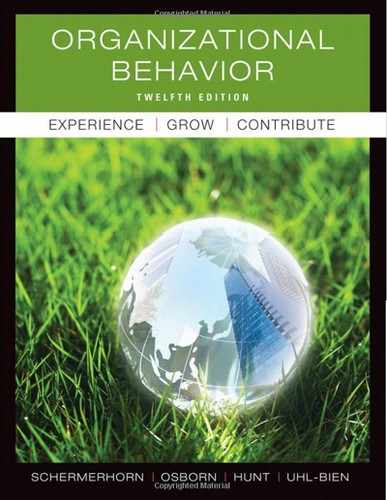contents
part 1 Organizational Behavior Today
1 Introducing Organizational Behavior
Introducing Organizational Behavior
Why Organizational Behavior Is Important
Scientific Foundations of Organizational Behavior
Organizational Behavior in a Changing World
Organizations as Work Settings
Organizational Behavior in Context
Organizational Environments and Stakeholders
Diversity and Multiculturalism
Managerial Activities and Roles
Ethical Management and Leadership
Learning about Organizational Behavior
Learning Guide to Organizational Behavior 12/E
part 2 Individual Behavior and Performance
2 Individual Differences, Values, and Diversity
Self-Awareness and Awareness of Others
Challenges in Managing Diversity
3 Emotions, Attitudes, and Job Satisfaction
Understanding Emotions and Moods
How Emotions and Moods Influence Behavior
Cultural Aspects of Emotions and Moods
Emotions and Moods as Affective Events
How Attitudes Influence Behavior
Linking Attitudes and Behavior
Attitudes and Cognitive Consistency
Job Satisfaction and Its Importance
Components of Job Satisfaction
How Job Satisfaction Influences Work Behavior
Linking Job Satisfaction and Job Performance
4 Perception, Attribution, and Learning
Factors Influencing Perception
Information Processing and the Perception Process
Perception, Impression Management, and Social Media
Perception, Attribution, and Social Learning
Attribution and Social Learning
Operant Conditioning and the Law of Effect
Equity Theory Predictions and Findings
Equity and Organizational Justice
Expectancy Theory of Motivation
Expectancy Implications and Research
Goal-Setting Theory of Motivation
Motivational Properties of Goals
Goal Setting and the Management Process
Integrated Model of Motivation
Intrinsic and Extrinsic Rewards
Motivation and Performance Management
Performance Management Process
Performance Measurement Methods
Performance Measurement Errors
Job Enlargement and Job Rotation
part 3 Teams and Teamwork
Organizations as Networks of Teams
Cross-Functional and Problem-Solving Teams
Social Loafing and Team Problems
Membership Composition of the Team
Diversity and Team Performance
8 Teamwork and Team Performance
Characteristics of High-Performance Teams
Task and Maintenance Leadership
Assets and Liabilities of Team Decisions
Groupthink Symptoms and Remedies
9 Decision Making and Creativity
Ethical Reasoning and Decision Making
Risk Management in Decision Making
Systematic and Intuitive Thinking
Decision-Making Traps and Issues
Functional and Dysfunctional Conflict
Hierarchical Causes of Conflict
Indirect Conflict Management Strategies
Direct Conflict Management Strategies
Negotiation Goals and Outcomes
Ethical Aspects of Negotiation
Organizational Settings for Negotiation
Approaches to Distributive Negotiation
How to Gain Integrative Agreements
Third-Party Roles in Negotiation
part 4 Influence Processes and Leadership
11 Communication and Collaboration
Collaborative Work Environments
Supportive Communication Principles
Interdependence, Legitimacy, and Power
Acceptance of Authority and the Zone of Indifference
Sources of Power and Influence
Relational Influence Techniques
From Empowerment to Valuing People
Traditions of Organizational Politics
Behavioral Leadership Perspectives
Situational Contingency Leadership
Fiedler's Leadership Contingency View
Hersey and Blanchard Situational Leadership Model
Implicit Leadership Theories (ILTs)
Implicit Followership Theories
Inspirational and Relational Leadership Perspectives
Transactional and Transformational Leadership
14 Leadership Challenges and Organizational Change
Shared Leadership in Work Teams
Shared Leadership and Self-Leadership
Leadership Aspects and Culture
Culturally Endorsed Leadership Matches
Universally Endorsed Aspects of Leadership
Contexts for Leadership Action
part 5 Organizational Context
15 Organizational Culture and Innovation
Functions of Organizational Culture
Subcultures and Countercultures
National Culture and Corporate Culture
Understanding Organizational Cultures
Stories, Rites, Rituals, and Symbols
Shared Values, Meanings, and Organizational Myths
Product and Process Innovations
Balancing Exploration and Exploitation
Managing Organizational Culture and Innovation
Management Philosophy and Strategy
Building, Reinforcing, and Changing Culture
Tensions Between Cultural Stability and Innovation
16 Organizational Goals and Structures
Centralization and Decentralization
Organizing and Coordinating Work
Traditional Types of Departments
Mechanistic Structures and the Machine Bureaucracy
Organic Structures and the Professional Bureaucracy
17 Strategy, Technology, and Organizational Design
Strategy and Organizational Learning
Linking Strategy and Organizational Learning
Strategy and Organizational Design
Organizational Design and Strategic Decisions
Organizational Design, Age, and Growth
Smaller Size and the Simple Design
Technology and Organizational Design
Operations Technology and Organizational Design
Adhocracy as a Design Option for Innovation and Learning
Information Technology and Organizational Design
Environment and Organizational Design
Strategic Leadership of the Whole Organization
Strategic Leadership and the Challenges at Multiple Levels
Developing a Top-Management Team
Using Top-Management Leadership Skills
Student Leadership Practices Inventory
